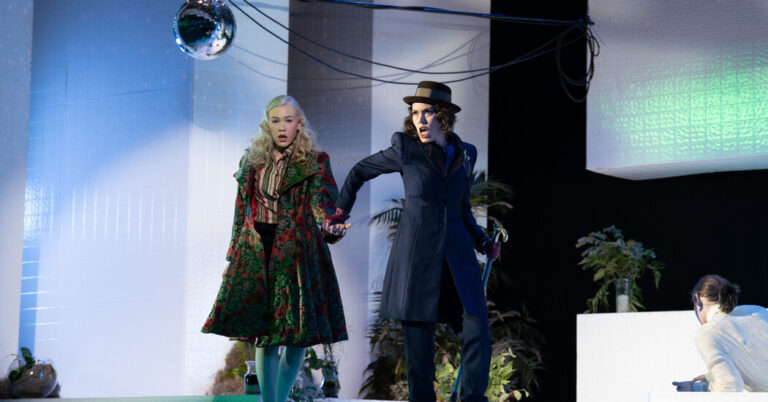
Darrah’s production is a mixture of scrappiness and chic, and emphasizes the otherworldliness of Soper’s conception. Prairie T. Trivuth’s set, lit starkly by Pablo Santiago, depicts the garden as a pristine white courtyard dotted with potted plants and, eventually, dripping with blood. Molly Irelan’s costumes, with period cuts, vivid fabrics and sparkling touches, further the opera’s mood of pert pastiche. Its Baroque references connect medieval France to the glittery splendor of 17th-century allegorical court masques.
In keeping with Soper’s stylistic variety, the cast comes from a range of musical backgrounds but shares a commitment to making the bountiful, erudite text legible. (The supertitles, for once, aren’t really necessary.) As the Dreamer, Lucas Steele has a sweet voice and Disney-prince ingenuousness with a self-referential wink. Radiating a charming mixture of naïveté and intelligence, Tivoli Treloar has a light mezzo-soprano flexible enough to convey all the Lover’s changes of perspective.
As the God of Love, Phillip Bullock travels from airy falsetto to basso profundo depths. Anna Schubert is a fiercely articulate Lady Reason, Laurel Irene a punkish Shame. Tiffany Townsend and Bernardo Bermudez bring rich-toned gusto to Idleness and Pleasure, here a couple of louche lounge lizards.
“The Romance of the Rose” isn’t perfect. The piece experiments with giving each of the three main allegorical foils a distinctive live-electronic vocal processing identity — Lady Reason, angular vocoding; the God of Love, echoey reverb; Shame, angry distortion. But even if it had been more perfectly executed, this conceit feels like a complication too many in an already complicated piece.
Soper’s previous major stage works, “Here Be Sirens” (2014) and “Ipsa Dixit,” were substantial single acts. Conceiving “The Romance of the Rose” in two acts was Soper setting a new challenge for herself, not just in length but also in structure. What, in theater, should prompt an intermission, and what brings the audience back for more? What hunger in the first act does a second act satisfy; what crisis is resolved?
These are questions that “The Romance of the Rose” doesn’t entirely solve. The second act feels like more of the same, with a somewhat blurrier version of the characters having the same debates they had before the break. (The production could be clearer in the final half, too.)